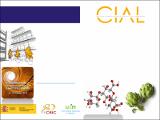Por favor, use este identificador para citar o enlazar a este item:
http://hdl.handle.net/10261/205154COMPARTIR / EXPORTAR:
 SHARE
BASE SHARE
BASE
|
|
| Visualizar otros formatos: MARC | Dublin Core | RDF | ORE | MODS | METS | DIDL | DATACITE | |

| Título: | GC‐MS characterisation of novel pectic‐oligosaccharides derived from artichoke pectin using machine learning and competitive fragmentation modelling (CFM‐ID) |
Autor: | Sabater, Carlos CSIC ORCID ; Montilla, Antonia CSIC ORCID ; Corzo, Nieves CSIC ORCID | Fecha de publicación: | 2019 | Citación: | 1st Iberian Meeting in Separation Sciences and Mass Spectrometry (2019) | Resumen: | Pectic oligosaccharides (POS) comprise a wide variety of structures containing different monomers including galacturonic acid (GalA), rhamnose (Rha), xylose (Xyl), arabinose (Ara) or galactose (Gal). To characterise these mixtures, several chromatographic techniques might be employed. GC‐MS‐EI is widely used in the field of metabolomics due to its reproducibility and simplicity. It generates massive amounts of high‐dimensional data and standards of many oligosaccharides might not be commercially available. To interpret GC‐MS‐EI results, in silico fragmentation methods such as CFM‐ID have been developed. On the other hand, machine learning allows extracting chemically relevant information from complex GC‐MS‐EI spectra. Therefore, the purpose of this study was to characterise novel POS obtained from hydrolysis of artichoke pectin using different types of enzymes. With this aim, a GC‐MS‐EI data analysis strategy based on the combination of machine learning and in silico fragmentation to interpret these models is presented. First, POS were obtained from pectin using different glycosidases (Pectinex Olio, PO; Cellulase from Aspergillus niger, CEL; Pentopan, PEN) and then reaction mixtures were analysed by GC‐MS‐EI. Spectra of di‐ and tri‐POS were classified by determining structural patterns depending on the enzyme selected. Models used like random forests and artificial neural networks led to high prediciton rates, showing accuracies over 95% on clasification of new samples. After, chemical structures of most influent m/z ions were calculated using an oligosaccharide in silico fragmentation library previously generated using CFM‐ID. Some relevant ions in POS obtained with PO (m/z 340, 424 and 443) were originated from Rha‐ɑ(1,4)‐GalA, GalA‐ɑ(1,2)‐Rha or Xyl‐ɑ(1,3)‐GalA (methylated/acetylated or not). Similarly, POS obtained with CEL showed high abundances of m/z 482, derived from GalAɑ(1,2)‐Rha (acetylated) and Xyl‐ɑ(1,3)‐GalA (acetylated). In contrast, POS obtained with PEN showed high abundances of m/z 454 which could also be formed from POS containing Araɑ(1,4)‐Rha. In conclusion, this methodology allows to tentatively predict some of the most probable POS structures that may be obtained from artichoke pectin using different enzymes. | Descripción: | Trabajo presentado al 1st Iberian Meeting on Separation Sciences and Mass Spectrometry (XIX Conference of the Spanish Society of Chromatography and Related Techniques - IX Conference of the Spanish Society of Mass Spectrometry - VI Conference of the Mass Spectrometry Group of the Portuguese Society of Chemistry), celebrado en Santiago de Compostela del 8 al 11 de octubre de 2019. | URI: | http://hdl.handle.net/10261/205154 |
| Aparece en las colecciones: | (CIAL) Comunicaciones congresos |
Ficheros en este ítem:
| Fichero | Descripción | Tamaño | Formato | |
|---|---|---|---|---|
| GC-modelli.pdf | 2,91 MB | Adobe PDF |  Visualizar/Abrir |
CORE Recommender
Page view(s)
151
checked on 23-abr-2024
Download(s)
76
checked on 23-abr-2024
Google ScholarTM
Check
NOTA: Los ítems de Digital.CSIC están protegidos por copyright, con todos los derechos reservados, a menos que se indique lo contrario.
